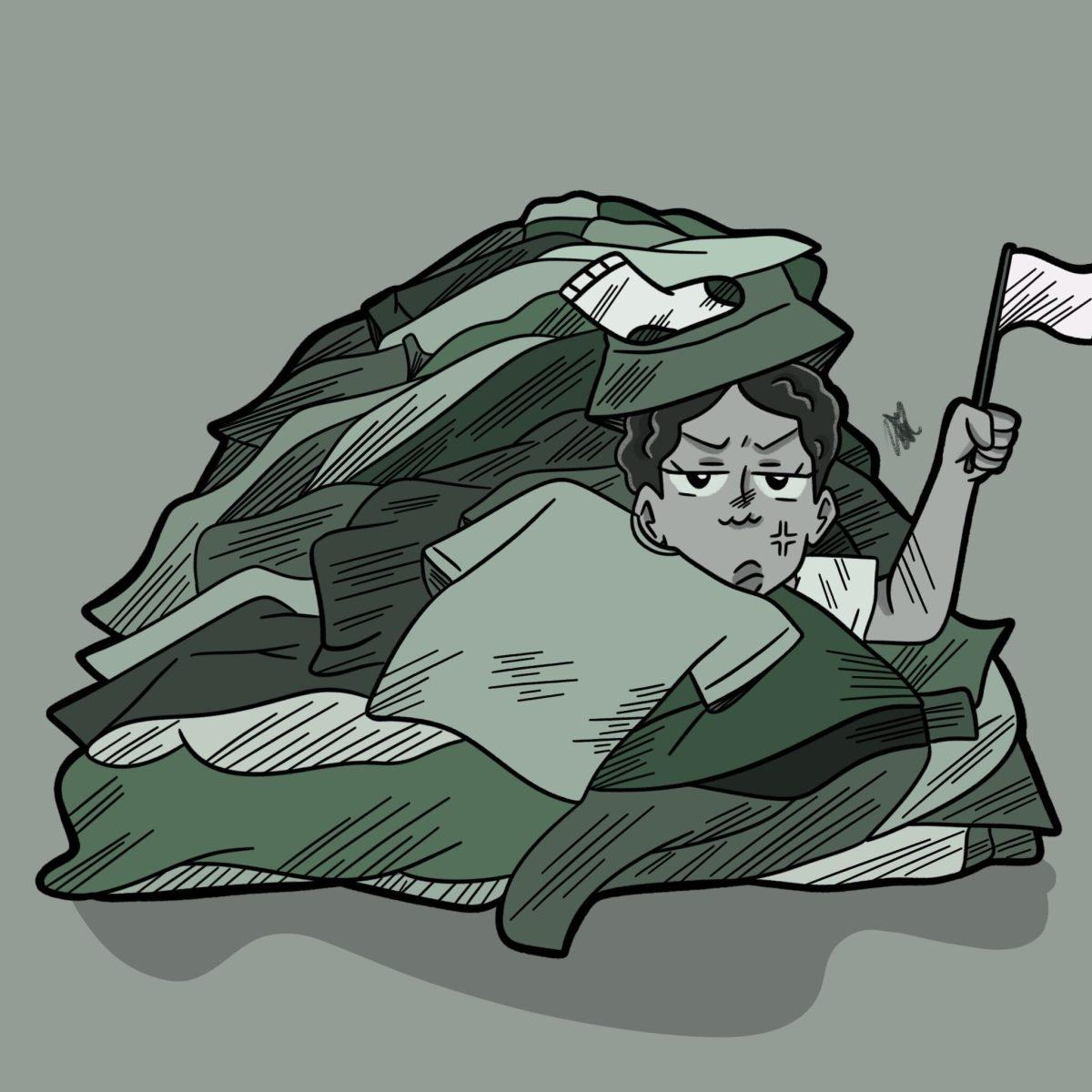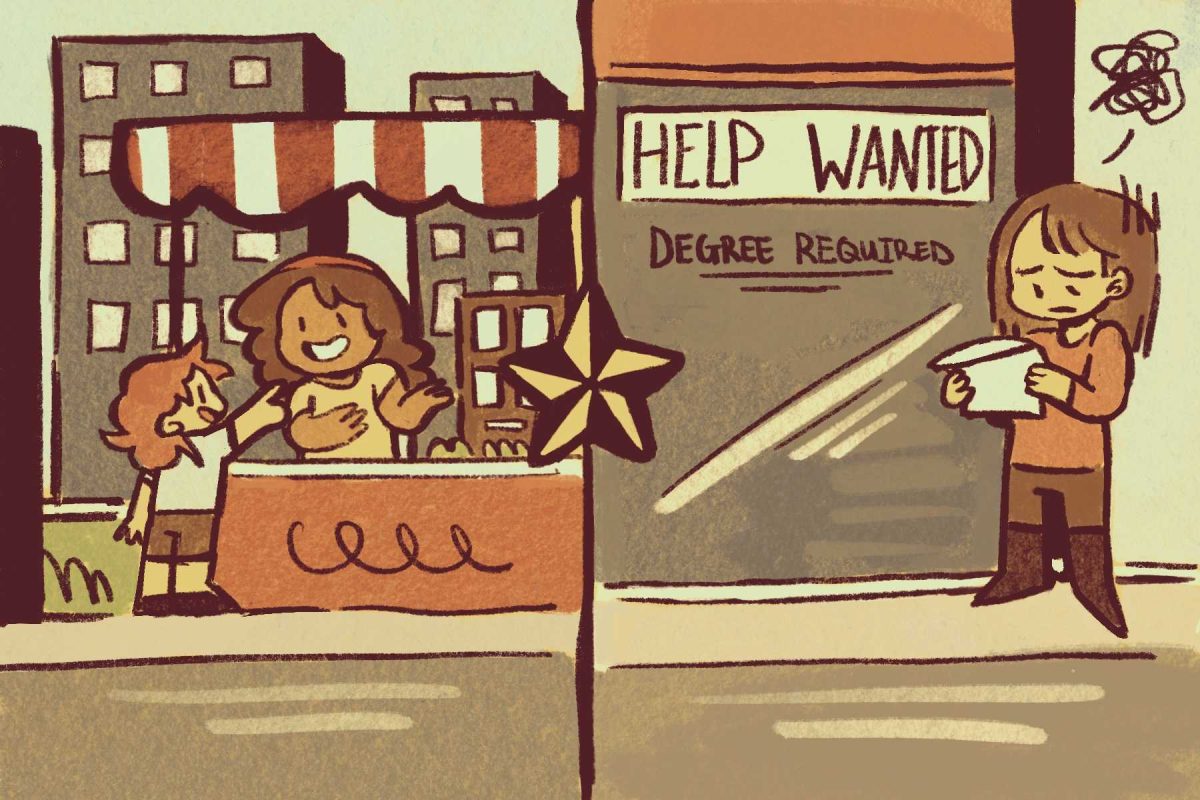Avoiding fast fashion can be difficult for college students who have limited income and time, and there is a need for a middle ground.
Fast fashion is a phrase used to describe trendy, inexpensive clothing found online or in popular stores. While many are lured in by the stylish items, unbelievably low price points and massive sales, they are repulsed to learn many of the unethical business practices that the fast fashion industry participates in, such as textile waste, child labor and underpaying its workers.
Though 80% of university students did not have a clear understanding of the harms of fast fashions in a January 2017 study, growing climate concerns amongst Generation Z are leading students to seek more knowledge on the topic. However, once one is aware of the ubiquity of fast fashion, it can be difficult to avoid.
The accessibility of fast fashion brands makes the temptation and convenience difficult for college students to pass up. Many brands notorious for fast fashion practices, such as H&M and Forever 21, have widespread and flashy storefronts. Meanwhile, stores with online models, such as Shein and Fashion Nova, are constantly pumping out new styles to match microtrends.
Shein is one of the worst offenders; a study conducted by Sheng Lu from the University of Delaware found that in twelve months, the Gap listed 12,000 items on its site, H&M listed 25,000, Zara listed 35,000 and Shein listed 1.3 million. Even more startlingly, Shein releases up to 6,000 items a day on average on its site. Online fast fashion stores also use time counters, limited-time-only sales and aptly placed product recommendations to create a sense of urgency and encourage users to purchase more than they initially intended.
It is understandable how those who are unaware of fast fashion — or even those who are but are short on resources or alternative options — can be lured in. The temptation becomes even stronger for college students because these stores, which offer fast shipping for low prices or weekend hours at storefronts, serve as a place for them to quickly purchase clothing.
To make matters worse, fast fashion brands often employ influencers from Youtube, TikTok and Instagram to create outfits and haul videos for them. Because of the fast-moving nature of social media trends, these influencers often encourage their followers to purchase new items or even a new wardrobe as each trend comes and goes.
Even those who desire to wear their new items after the trend has passed will not have much luck; studies show that designs for clothing sold at fast-fashion retailers are designed to be worn less than ten times. Because of the low price point, buyers are less concerned about discarding the item and purchasing a new one, but that only worsens the growing textile waste problem in America, which has doubled from seven million tons to 14 million tons annually in the past 20 years.
Shopping for sustainable clothing brands can be expensive and the items are often outside of a college student’s meager budget. This is an expense that can be difficult to avoid because the very things that make fast fashion cheap are what makes it unsustainable and unethical. Mateusz Zawada, chief financial officer of Starseeds, a slow fashion clothing brand based in London, states that the prices of sustainable fabrics can be two to four times the cost of non-sustainable fabrics. This is due to the expensive processes that are used to cultivate sustainable fabrics plus low demand from other clothing companies, who often opt for cheaper fabrics such as polyester.
Ethical fashion brands have a difficult time competing with fast fashion brands because fast fashion brands often severely undercut the wages of factory employees in order to offer such rock-bottom prices, something ethical fashion brands are unwilling to do.
According to the Garment Worker Center in Los Angeles, most garment workers in California work for 60 to 70 hours a week in dirty, dangerous conditions, and are paid at a rate of two to six cents per piece instead of a minimum wage. These workers, often women of color and immigrants, only take home $300 a week on average. Many major fashion brands rely on such cheap labor to not only maintain their low prices but to remain in business; increasing their wages would risk their bottom line, so they see no incentive to do so.
College students with an interest in both fashion and more ethical, sustainable business practices find that, outside of a sizeable income or financial support from parents, switching to sustainable clothing is more easily said than done. The median dependent college student earned $3,900, and the median independent college student earned $13,880 in the 2015-2016 school year — wages that are insufficient for quality clothing. As a result, students must look elsewhere to shop sustainably.
Thrifting is the best, most immediate alternative to fast fashion. Though it is a valuable option, it has its drawbacks. The styles, sizes and items available in thrift stores vary widely depending on those donating in that area. Those who do not have thrift stores that stock their sizes or style nearby can often turn to the Internet to use resell apps such as Poshmark and Depop to purchase secondhand clothing, often at discounted rates.
Many times, people interested in thrift shopping cannot find items that suit them, and most often, plus-sized people bear the brunt of this exclusion. Plus-sized women have frequently spoken about their difficulties finding clothing that is fashionable and well-fitting, and these issues often compound in secondhand shopping.
Because the fashion industry did not mass produce for plus-sized women for several decades, there are fewer plus-sized vintage and second-hand items to go around. For those that do exist, the competition is fierce, even amongst straight-sized women who like to wear some plus-sized items as oversized pieces. As a result, many plus-sized women leave thrift stores empty-handed and discouraged and often turn to fast fashion, which is generally more size-inclusive and inexpensive.
Additionally, the rise in the popularity of thrift shopping has raised questions about its gentrification. Popular thrift stores have raised prices, pricing out the poor and working-class shoppers who were the original target market. Those shoppers report via social media that they find that wealthier shoppers or thrift resellers buy the more fashionable clothes in large quantities. While it seems unfair to lay the sole blame for rising thrift store prices at the feet of new shoppers than the institutions that choose to increase prices, those concerned about possible gentrification may find it is better for them to limit their thrift shop purchases.
Detractors and cynics argue that searching for a viable middle ground is futile under our current economic system because most fashion brands, whether cheap or luxury, use some sort of exploitation or unsustainable resources. While I acknowledge the difficulties of creating a product that is perfectly free of exploitation and 100% sustainable, I believe that pushing for a product that is any measure of an improvement is a massive step in the right direction.
College students who have the time and resources to shop sustainably or buy secondhand should absolutely do so but there is a need for sustainable fashion available at low prices for all students. Until that solution is found, the best we can do is consume less, take good care of our clothing, seek out better quality clothing and demand better business practices from fashion executives.
-Tiara Allen is a marketing senior
The University Star welcomes Letters to the Editor from its readers. All submissions are reviewed and considered by the Editor-in-Chief and Opinion Editor for publication. Not all letters are guaranteed for publication.
Opinion: College students need more sustainable clothing options
Tiara Allen, Opinion Contributor
June 11, 2022
0
Donate to The University Star
Your donation will support the student journalists of Texas State University. Your contribution will allow us to purchase equipment and cover our annual website hosting costs.
More to Discover















